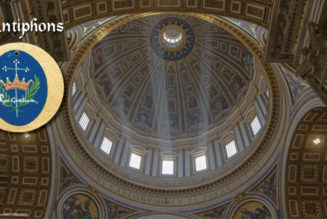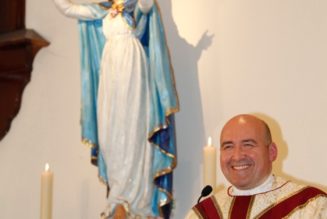Day) of Mary, Mother of God. To call
Mary the “Mother of God” must not be understood as a claim for Mary’s
motherhood of divinity itself, but in the sense that Mary was mother of Jesus,
who is truly God. The Council of Ephesus
in 431—long before the schisms with the Eastern churches and the
Protestants—proclaimed “Mother of God” a theologically correct title for
Mary.
division, the common confession of Mary as “Mother of God” should unite all
Christians, and distinguish Christian orthodoxy from various confusions of it,
such as Arianism (the denial that Jesus was God) or Nestorianism (in which Mary
mothers only the human nature of Jesus but not his whole person).
Readings for this Solemnity: (1) the person of Mary, and (2) the name of Jesus.
Why the name of Jesus? Prior to the
second Vatican Council, the octave day of Christmas was the Feast of the Holy Name, not Mary Mother of God. The legacy of that tradition can be seen in
the choice of Readings for this Solemnity.
(The Feast of the Holy Name was removed from the calendar after Vatican
II; St. John Paul II restored it as an optional memorial on January 3, which
this year falls on this coming Friday. While the Holy Name is an optional memorial, The Solemnity of Mary Mother of God on January 1 is a holy day of obligation, meaning that it is a mortal sin knowingly and consciously to skip mass on that day.)
Reading is Numbers 6:22-27
said to Moses:
“Speak to Aaron and his sons and tell them:
This is how you shall bless the Israelites.
Say to them:
The LORD bless you and keep you!
The LORD let his face shine upon
you, and be gracious to you!
The LORD look upon you kindly and
give you peace!
So shall they invoke my name upon the Israelites,
and I will bless them.”
very few times that the Book of Numbers is read on a Lord’s Day or Feast
Day. Here’s a little background on the
Book of Numbers:
Book of Numbers is a little less neglected than Leviticus among modern
Christian readers, if only because, unlike its predecessor, it combines its
long lists of laws with a number of dramatic narratives about the rebellions of
Israel against God in the wilderness, which create literary interest. The name “Numbers” is, perhaps, already
off-putting for the modern reader—it derives from the Septuagint name Arithmoi, “Numbers”, referring to the
two numberings or censuses, one each
of the first and second generations in the Wilderness, that form the pillars of
the literary structure of the book in chs. 1 and 26. The Hebrew name is bamidbar, “In the Wilderness,” which is an accurate description of
the geographical and spiritual location of Israel throughout most of the
narrative.
literary relationship with its neighbors in the Pentateuch. In many ways it corresponds with the Book of
Exodus. Exodus begins with the people staying
in Egypt (Exodus 1-13), then describes their journey to through the desert
(Exodus 14-19), and ends with them stationary at Sinai (20-36). Numbers begins with the people staying at
Sinai (Num 1-10), describes their journey through the desert (Num 11-25), and
ends with them stationary on the Plains of Moab. Sinai and the Plains of Moab correspond: at
each location the people will receive a covenant (see below on
Deuteronomy). Furthermore, there are
strong literary connections between the journeys through the Wilderness to and
from Sinai (Ex 14-19; Num 11-25). Both
these sections are dominated by accounts of the people of Israel “murmuring”
(Heb. lôn), “rebelling” (Heb. mārāh), or “striving” (Heb. rîb) against the LORD and/or Moses,
together with Moses’ need for additional help to rule an unruly people (Ex 18;
Num 11:16-39), and God’s miraculous provision for the people’s physical needs
(Ex 15:22-17:7; Num 11:31-34; 20:1-13).
This is evidence of careful literary artistry: the central Sinai
Narrative (Exod 20–Num 10) is surrounded by the unruly behavior of the people
wandering in the desert.
with Leviticus. If Leviticus established
a sacred “constitution” for the life of Israel, exhibiting a logical,
systematic order concluded, like a good covenant document, with a listing of
blessings and curses (Lev 26), Numbers is more like a list of “amendments” to
the “constitution,” together with accounts of the historical circumstances that
led to their enactment. And like the
lists of amendments on many state and national constitutions, the laws have an ad hoc, circumstantial character, with
little logical connection between successive “amendments.”
the Book of Deuteronomy, providing us the necessary information about Israel’s
geographical and moral condition when they arrived at the “Plains of Moab
opposite Jericho” in order to appreciate Moses’ extended homily and renewal of
the covenant that he will deliver at this site in the final book of the
Pentateuch.
this First Reading is the famous Priestly Blessing of Numbers 6. The formula for blessing given to the priests
involves the invocation of the Divine Name (YHWH) three times over the people
of Israel.
Excursus on the Divine Name
say?” “God said to Moses, “I AM WHO I AM,” say … “I AM has sent me to you” (Ex
3:13-14). The revelation of the divine
Name to Moses (Ex 3:13-15) is one of the most theologically significant
passages of the Old Testament. By
revealing himself as “I AM”, God distinguishes himself from the other gods of
the nations, which “are not.” He is the
only God who truly is. Furthermore, the
name “I AM” stresses that God exists of himself; unlike all other beings he
does not take his existence from some other cause. Later philosophical language will describe
God as the one necessary being. While
lacking technical philosophical language, the ancients did have the concept of
self-existence: in Egyptian religion, the sun-god Amon-Rē “came into being by
himself” and all other beings took their existence from him. However, God reveals to Moses that it is He,
the LORD—not Amon-Rē or any other Egyptian god—who is the ground of being and
the source of existence.
of God is spelled YHWH in the English equivalents of the Hebrew consonants. It
is not the full phrase “I AM WHO I AM” but rather an archaic form of the Hebrew
verb HYH, “to be,” with the meaning “HE IS.” Out of respect for the third
commandment, Jews after the Babylonian exile (c. 597–537 BC) ceased to
pronounce the divine name at all, but instead substituted the title “Lord,” in
Hebrew adonai, in Greek kyrios. Thus the God of Israel is called ho
kyrios, “the Lord” in the New
Testament. This sheds light on the
meaning of the phrase, “Jesus is Lord!” (Rom 10:9; 1 Cor 12:3).
around AD 700, when Jewish scribes developed a vowel-writing system. The form YHWH, however, was written with the
vowels for adonai, the word Jews actually pronounced.
The English translators of the King James Version did not understand
this system, and in a few instances combined the Hebrew consonants of YHWH
(called the tetragrammaton, lit. “the
four letters”) with the Hebrew vowels of adonai to form the erroneous name “Jehovah.”
Catholic tradition addresses God with neither the mistaken form
“Jehovah” nor the ancient pronunciation “Yahweh,” but uses “LORD” to refer to
the God of Israel, in keeping with the practice of Jesus and the Apostles. In most English Bibles, “LORD” in caps
represents YHWH in the Hebrew text, while “Lord” in lower case represents the
actual Hebrew word adonai.
Hebrew culture was of great significance.
The “name” represented the essence of the person, and invoking the name
made the person mystically present.
Therefore, God will speak of the manifestation of his presence in the
Temple as the “dwelling of his Name” in various places of the Old Testament.
God over the people of Israel communicates God’s presence and Spirit to them at
least a mediated way. Although I cannot prove it, it is my personal belief that
the formula recorded in Numbers 6 was the standard formula for bestowing a
blessing “in the Name of the LORD,” and the authority to bestow such a blessing
was reserved to those with priestly authority.
Later in the Scriptures, when reference is made to blessing persons “in
the Name of the LORD,” I believe it refers to the recitation of this formula
(Deut 21:5; 2 Sam 6:18; Sir 50:20).
Divine Name (YHWH) was seldom if ever pronounced, except on the Day of
Atonement (Yom Kippur), when the High
Priest would make atonement for the whole nation in the Holy of Holies, and
then exit the Temple in order to bless the assembled people in the Temple
courts. There, he would pronounce the
blessing of Numbers 6, including the vocalization of the Divine Name. Every time the people would hear the Name
pronounced, they would drop prostrate on the ground. This is recorded in Sirach:
hands over the whole congregation of the sons of Israel, to pronounce the
blessing of the Lord with his lips, and to glory in his name, and to glory in
his name; 21 and they bowed down in worship a second time, to receive the
blessing from the Most High.
recorded in the Mishnah, the
second-century AD collection of rabbinic tradition and teaching that become the
basis of the legal system of modern Judaism.
So in the Mishnah, tractate Yoma 3:8 and 6:2:
the people heard the four letter Name] they answer after [the High Priest]:
“Blessed be the Name of His glorious Kingdom forever and ever”. (M. Yoma 3:8)
priests and the people standing in the courtyard, when they heard the explicit
Name from the mouth of the High Priest, would
bend their knees, bow down and fall on their faces, and they would say, “Blessed be the Honored Name
of His Sovereignty forever!” (M.
Yoma 6:2)
Scripture in today’s liturgy for a variety of reasons.
people around the world on this, the first day of the civil year, to ask from
God his blessing upon us.
the Gospel) the circumcision and naming
of Jesus. For us in the New Covenant,
the Name of God continues to be a source of blessing and Divine Presence, but
the name we are to use is no longer YHWH
but “Jesus.” Jesus is God’s Name, the
source of salvation. When Paul speaks to
the Philippians about the Name of Jesus, he may have in mind the prostrations
in the Temple at the Divine Name:
the name of Jesus every knee should bow, in heaven and on earth and under the
earth …
Christian tradition to pronounce the holy name “YHWH.” Jesus and the Apostles practiced the Jewish
piety of substituting “Lord” (‘adonai,
kyrios, dominus) for the pronunciation of the Name. For this reason, under the pontificate of
Benedict XVI, the pronounced name “Yahweh” was removed from contemporary
worship resources. The sect of the
Jehovah’s Witnesses insist on the pronunciation of the Name, although their
form of pronunciation is erroneous, and there is nothing in Christian tradition
or the New Testament to encourage such a practice. For us, the saving name is now “Jesus,” and
although full prostration at the pronunciation of the name of Jesus is
impractical, Catholic piety dictates a bow of the head at the mention of the
Holy Name.
Reading is Galatians 4:4-7:
Gospel, which emphasizes Mary’s role in Christ’s birth (“born of a woman”) as
well as Jesus and his family being obedient Jews, faithful to the Old Covenant
in submitting to circumcision (“born under the law.”)
that Jesus calls us to Divine sonship (or childhood, if gender neutrality is
desired). Let’s not forget that this is
unique to the Christian faith.
Christianity—unlike Judaism, Islam, Buddhism, Hinduism, and Atheism—is a
religion about becoming children of God.
In Judaism, Divine childhood is metaphorical; in Islam, it is
blasphemy. In Eastern religions, it is
irrelevant, because God is not ultimately a personal being, but rather an
impersonal force or essence that animates all or simply is All. Christianity alone holds out the possibility
of familial intimacy with Creator as a son or daughter to a Father.
connection between the gift of the Holy Spirit and divine sonship. From a legal
perspective, it is the New Covenant that makes us children of God; from an ontological perspective, it is the
Spirit that makes us children. The
sending of the Spirit “into our hearts,” as St. Paul says, is parallel to the
inbreathing of the “breath of life” into the nostrils of Adam, causing him to
become “a living being.” So we are
revivified by the Holy Spirit, as Adam was brought to life at the dawn of
time. Adam was king of the universe, as
it says: “Have dominion over the over the fish of the sea and over the birds of
the air and over every living thing that moves upon the earth” (Gen 1:28). The word “dominion” (Heb radah) evokes the context of kingly rule: later it will be used of
Solomon’s imperial reign (1 Kings 4:24; Ps 72:8; 110:2; 2 Chr 8:10). So the Holy Spirit makes us royalty in
Christ: as St. Paul says, “no longer a slave but a son … also an heir, through
God.” No longer a slave to what? Sin, death, and the devil. If we live controlled by lusts, in fear of
death, and swayed by the suggestions of Satan, than we are still slaves. If we are free of these things, then we are
walking in the Spirit, as children of God.
This is a theme in the First Epistle of John, which is read during daily
mass all through the Christmas season.
is Luke 2:16-21:
Mary and Joseph,
“kept all these things, reflecting on them in her heart.” This is not only an historical indication of
where St. Luke is getting his information about these events (so John Paul II [in
his Wednesday audience of Jan. 28, 1987] and the Catholic tradition generally),
but also a model of the contemplative vocation to which all Christians are
called. Especially during this Christmas
season, up until the Baptism (Jan 13), we should carve out some time for quiet
prayer, to meditate on the incredible events we celebrate and allow their
meaning to sink into our hearts.
“glorifying and praising God for all they had heard and seen …” This, too, describes the Christian’s
vocation. Pope Francis in particular has
called us to return to the aspect of praise and joy that characterizes the
disciple of Jesus. Our faith is
experiential, it is not just a philosophy.
It is an encounter with a person.
All of us should know what it means to come into contact with Jesus, to
“hear and see” him. In his First Epistle
(which we are reading right now in daily mass), St. John sounds much like the
shepherds:
1:1 That which was from the beginning, which we have heard, which we have seen
with our eyes, which we have looked upon and touched with our hands, concerning
the word of life — 2 the life was made
manifest, and we saw it, and testify to it, and proclaim to you the eternal
life which was with the Father and was made manifest to us — 3 that which we have seen and heard we
proclaim also to you, so that you may have fellowship with us; and our fellowship
is with the Father and with his Son Jesus Christ. 4 And we are writing this that our joy may be
complete.
this passage with “seeing” and “hearing” and the culmination in proclamation
and joy. This is what disciples of Jesus
do: they experience Jesus and then proclaim in joy what they have encountered.
Jesus at his circumcision. Christians no
longer practice circumcision, because Baptism is the “circumcision of the
heart” promised by Moses that surpasses physical circumcision (cf. Deut 10:16;
30:6; Acts 2:37; Col 2:11-12). Yet at
our Baptism, the “circumcision of our heart,” we still receive our Christian
name.
the Hebrew word y’shua, meaning
“salvation.” In the Old Testament, we
are more familiar with the name under the form “Joshua,” who was an important
type of Christ. Just as Moses was unable
to lead the people of Israel into the promised land, but Joshua did; so also
Jesus is our New Joshua who takes us into the salvation to which Moses and his
covenant could not lead us.
Name of Jesus, because salvation means to enter into a relationship of
childhood with God the Father. It’s not
that other great religious leaders (Mohammed, Buddha, Confucius etc.) claimed
to be able to lead us into divine childhood, but couldn’t. It’s that they did not even claim to be able to do so. Jesus is unique. So Jesus says, “I am the way, and the truth,
and the life; no one comes to the Father, but by me.” (John 14:6). This is not arrogance. Jesus is the only great religious founder in
human history to proclaim that God is a Father and we can become his children. This concept of divine filiation is at the heart of the Gospel. In a sense, it can be said to be the heart of the Gospel.
give thanks to God that he has, through Jesus, made a way for us to become his
children and receive a new name which he has given us (see Rev 2:17). This intimate, personal relationship with God
has been made possible by the cooperation of Mary, who became the mother of the
one whose Name is Salvation.
***
We are still looking for two more couples to come with us to Israel in June 2020! Dr. John Bergsma/Fr. Mark Bentz pilgrimage to the Holy Land June 14-23, 2020: info and sign-up is here!
<!– /* Font Definitions */
@font-face {font-family:"Cambria Math"; panose-1:2 4 5 3 5 4 6 3 2 4; mso-font-charset:0; mso-generic-font-family:roman; mso-font-pitch:variable; mso-font-signature:-536870145 1107305727 0 0 415 0;}
@font-face {font-family:Cambria; panose-1:2 4 5 3 5 4 6 3 2 4; mso-font-charset:0; mso-generic-font-family:roman; mso-font-pitch:variable; mso-font-signature:-536870145 1073743103 0 0 415 0;} /* Style Definitions */
p.MsoNormal, li.MsoNormal, div.MsoNormal {mso-style-unhide:no; mso-style-qformat:yes; mso-style-parent:""; margin:0in; margin-bottom:.0001pt; mso-pagination:widow-orphan; font-size:12.0pt; font-family:"Cambria",serif; mso-fareast-font-family:Cambria; mso-bidi-font-family:"Times New Roman";}
span.en {mso-style-name:en; mso-style-unhide:no; mso-style-parent:"";}
span.queryhighlighted {mso-style-name:query_highlighted; mso-style-unhide:no; mso-style-parent:"";}
.MsoChpDefault {mso-style-type:export-only; mso-default-props:yes; font-size:10.0pt; mso-ansi-font-size:10.0pt; mso-bidi-font-size:10.0pt; font-family:"Cambria",serif; mso-ascii-font-family:Cambria; mso-fareast-font-family:Cambria; mso-hansi-font-family:Cambria;}
@page WordSection1 {size:8.5in 11.0in; margin:1.0in 1.25in 1.0in 1.25in; mso-header-margin:.5in; mso-footer-margin:.5in; mso-paper-source:0;}
div.WordSection1 {page:WordSection1;}
–>






![During Holy Week, rapper Lil Nas X releases line of Satan-themed shoes (containing drop of human blood) to promote gay music video to kids [NYTimes paywall] …](https://salvationprosperity.net/wp-content/uploads/2021/04/during-holy-week-rapper-lil-nas-x-releases-line-of-satan-themed-shoes-containing-drop-of-human-blood-to-promote-gay-music-video-to-kids-nytimes-paywall-327x219.jpg)


